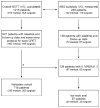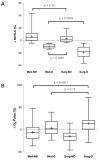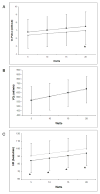Lung deflation and oxygen pulse in COPD: results from the NETT randomized trial
- PMID: 21843930
- PMCID: PMC3233645
- DOI: 10.1016/j.rmed.2011.07.012
Lung deflation and oxygen pulse in COPD: results from the NETT randomized trial
Abstract
Background: In COPD patients, hyperinflation impairs cardiac function. We examined whether lung deflation improves oxygen pulse, a surrogate marker of stroke volume.
Methods: In 129 NETT patients with cardiopulmonary exercise testing (CPET) and arterial blood gases (ABG substudy), hyperinflation was assessed with residual volume to total lung capacity ratio (RV/TLC), and cardiac function with oxygen pulse (O(2) pulse=VO(2)/HR) at baseline and 6 months. Medical and surgical patients were divided into "deflators" and "non-deflators" based on change in RV/TLC from baseline (∆RV/TLC). We defined deflation as the ∆RV/TLC experienced by 75% of surgical patients. We examined changes in O(2) pulse at peak and similar (iso-work) exercise. Findings were validated in 718 patients who underwent CPET without ABGs.
Results: In the ABG substudy, surgical and medical deflators improved their RV/TLC and peak O(2) pulse (median ∆RV/TLC -18.0% vs. -9.3%, p=0.0003; median ∆O(2) pulse 13.6% vs. 1.8%, p=0.12). Surgical deflators also improved iso-work O(2) pulse (0.53 mL/beat, p=0.04 at 20 W). In the validation cohort, surgical deflators experienced a greater improvement in peak O(2) pulse than medical deflators (mean 18.9% vs. 1.1%). In surgical deflators improvements in O(2) pulse at rest and during unloaded pedaling (0.32 mL/beat, p<0.0001 and 0.47 mL/beat, p<0.0001, respectively) corresponded with significant reductions in HR and improvements in VO(2). On multivariate analysis, deflators were 88% more likely than non-deflators to have an improvement in O(2) pulse (OR 1.88, 95% CI 1.30-2.72, p=0.0008).
Conclusion: In COPD, decreased hyperinflation through lung volume reduction is associated with improved O(2) pulse.
Copyright © 2011 Elsevier Ltd. All rights reserved.
Figures




References
-
- Vassaux C, Torre-Bouscoulet L, Zeineldine S, et al. Effects of hyperinflation on the oxygen pulse as a marker of cardiac performance in COPD. Eur Respir J. 2008;32:1275–82. - PubMed
-
- Butler J, Schrijen F, Henriquez A, Polu JM, Albert RK. Cause of the raised wedge pressure on exercise in chronic obstructive pulmonary disease. Am Rev Respir Dis. 1988;138:350–4. - PubMed
-
- Jorgensen K, Houltz E, Westfelt U, Nilsson F, Schersten H, Ricksten SE. Effects of lung volume reduction surgery on left ventricular diastolic filling and dimensions in patients with severe emphysema. Chest. 2003;124:1863–70. - PubMed
-
- Jorgensen K, Muller MF, Nel J, Upton RN, Houltz E, Ricksten SE. Reduced intrathoracic blood volume and left and right ventricular dimensions in patients with severe emphysema: an MRI study. Chest. 2007;131:1050–7. - PubMed
-
- Watz H, Waschki B, Meyer T, et al. Decreasing cardiac chamber sizes and associated heart dysfunction in COPD: role of hyperinflation. Chest. 2010;138:32–8. - PubMed
Publication types
MeSH terms
Grants and funding
- N01 HR076103/HL/NHLBI NIH HHS/United States
- T32 HL007633/HL/NHLBI NIH HHS/United States
- N01 HR076102/HL/NHLBI NIH HHS/United States
- N01 HR076114/HL/NHLBI NIH HHS/United States
- N01 HR076113/HL/NHLBI NIH HHS/United States
- N01 HR076104/HL/NHLBI NIH HHS/United States
- U10 HL074428/HL/NHLBI NIH HHS/United States
- N01 HR076101/HL/NHLBI NIH HHS/United States
- N01 HR076110/HL/NHLBI NIH HHS/United States
- T32HL007633-25/HL/NHLBI NIH HHS/United States
- N01 HR076112/HL/NHLBI NIH HHS/United States
- N01 HR076105/HL/NHLBI NIH HHS/United States
- N01 HR076118/HL/NHLBI NIH HHS/United States
- N01 HR076115/HR/NHLBI NIH HHS/United States
- N01 HR076107/HL/NHLBI NIH HHS/United States
- K25 HL104085/HL/NHLBI NIH HHS/United States
- K23HL089353-01A1/HL/NHLBI NIH HHS/United States
- N01 HR076106/HL/NHLBI NIH HHS/United States
- N01 HR076109/HL/NHLBI NIH HHS/United States
- U10HL074428-05/HL/NHLBI NIH HHS/United States
- N01 HR076119/HL/NHLBI NIH HHS/United States
- N01 HR076108/HL/NHLBI NIH HHS/United States
- N01 HR076116/HL/NHLBI NIH HHS/United States
- K23 HL089353/HL/NHLBI NIH HHS/United States
- N01 HR076111/HL/NHLBI NIH HHS/United States
LinkOut - more resources
Full Text Sources
Medical

